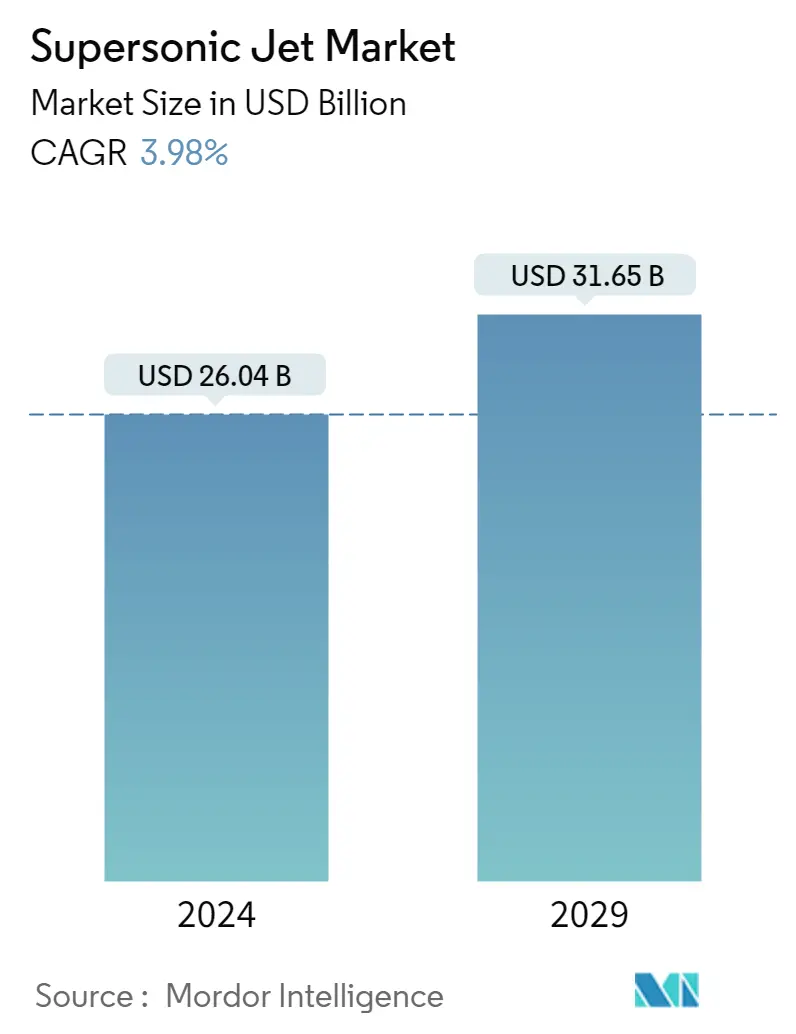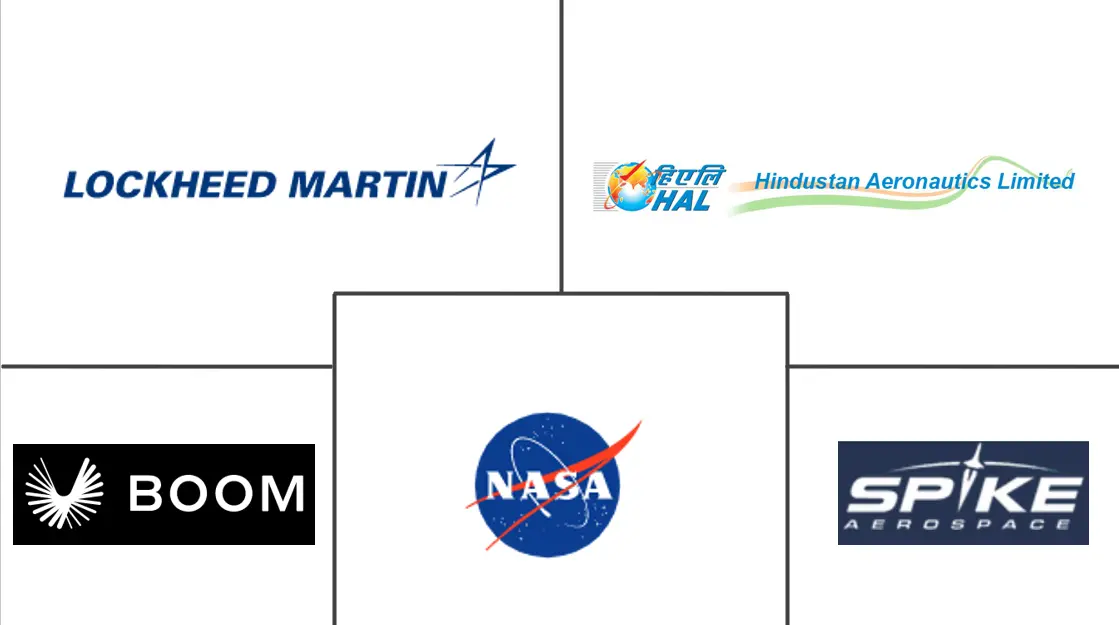Market Size of Supersonic Jet Industry

| Study Period | 2019 - 2029 |
| Market Size (2024) | USD 26.04 Billion |
| Market Size (2029) | USD 31.65 Billion |
| CAGR (2024 - 2029) | 3.98 % |
| Fastest Growing Market | North America |
| Largest Market | Asia-Pacific |
Major Players
*Disclaimer: Major Players sorted in no particular order |
Supersonic Jet Market Analysis
The Supersonic Jet Market size is estimated at USD 26.04 billion in 2024, and is expected to reach USD 31.65 billion by 2029, growing at a CAGR of 3.98% during the forecast period (2024-2029).
The onset of the COVID-19 pandemic had a moderate impact on the R&D programs of supersonic aircraft, as companies had to reassess their cost structures to stay economically viable. This led to temporary cost escalations for several ongoing programs, both in the commercial and defense sectors. Post-pandemic, the investments made toward the procurement of new combat aircraft and the development of commercial supersonic jets also increased significantly, resulting in a sharp recovery of the market.
As the commercial supersonic flight is banned in many countries, the market relies on a very small segment of customers, which restricts the growth of the commercial segment of the market. However, plans to re-commercialize supersonic travel are in the pipeline, which may trigger rapid growth during the forecast period.
Supersonic Jet Industry Segmentation
Supersonic planes go much faster than regular planes, but the vortex flow they experience puts a lot of stress on their structures.
The supersonic jet market is segmented based on size, type, speed, and geography. By size, the market is segmented into light, medium, and heavy. By type, the market is segmented into fighters and passengers. By speed, the market is segmented into Mach 1.0, Mach 2.0, and Mach 3.0. By geography, the market is segmented into North America, Europe, Asia-Pacific, the Middle East and Africa, and the Rest of the World. The market sizing and forecasts have been provided in value (USD million) for all the above segments.
| Size | |
| Light | |
| Medium | |
| Heavy |
| Type | |
| Fighter | |
| Passenger |
| Speed | |
| Mach 1.0 | |
| Mach 2.0 | |
| Mach 3.0 |
Supersonic Jet Market Size Summary
The supersonic jet market is poised for growth, driven by advancements in both commercial and defense sectors. The market's recovery post-COVID-19 is attributed to increased investments in new combat aircraft and the development of commercial supersonic jets. Despite challenges such as the ban on commercial supersonic flights in many countries, efforts to re-commercialize supersonic travel are underway, particularly in the United States, where NASA and the FAA are actively involved in developing and testing civilian supersonic aircraft. The passenger segment is expected to experience significant growth, with airlines like American Airlines and United Airlines making substantial commitments to purchase supersonic jets from Boom Supersonic. This growth is further supported by the rapid increase in air passenger traffic, prompting airlines to seek faster travel options.
Regionally, North America currently holds the largest market share due to substantial investments and R&D efforts by aviation companies. However, the Asia-Pacific region is anticipated to expand its market share, driven by a large user base and initiatives like Japan Airlines' investment in supersonic planes. Collaborative projects in the defense sector, such as the UK-Japan partnership on the Tempest fighter jet, highlight the global interest in supersonic technology. The market is highly consolidated, with key players like NASA, Lockheed Martin, and Boom Supersonic leading innovations to overcome existing challenges like sonic boom. Technological advancements, such as NASA's X-59 Quiet SuperSonic Technology, are expected to propel market growth during the forecast period.
Supersonic Jet Market Size - Table of Contents
-
1. MARKET DYNAMICS
-
1.1 Market Overview
-
1.2 Market Drivers
-
1.3 Market Restraints
-
1.4 Industry Attractiveness - Porter's Five Forces Analysis
-
1.4.1 Bargaining Power of Buyers/Consumers
-
1.4.2 Bargaining Power of Suppliers
-
1.4.3 Threat of New Entrants
-
1.4.4 Threat of Substitute Products
-
1.4.5 Intensity of Competitive Rivalry
-
-
-
2. MARKET SEGMENTATION
-
2.1 Size
-
2.1.1 Light
-
2.1.2 Medium
-
2.1.3 Heavy
-
-
2.2 Type
-
2.2.1 Fighter
-
2.2.2 Passenger
-
-
2.3 Speed
-
2.3.1 Mach 1.0
-
2.3.2 Mach 2.0
-
2.3.3 Mach 3.0
-
-
Supersonic Jet Market Size FAQs
How big is the Supersonic Jet Market?
The Supersonic Jet Market size is expected to reach USD 26.04 billion in 2024 and grow at a CAGR of 3.98% to reach USD 31.65 billion by 2029.
What is the current Supersonic Jet Market size?
In 2024, the Supersonic Jet Market size is expected to reach USD 26.04 billion.

